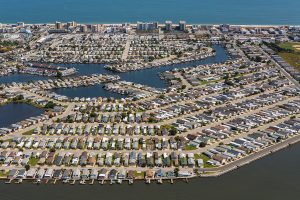
OCEAN CITY — Resort officials renewed the debate this week about encouraging more year-round residents through relaxing fees associated with new construction or creating other incentives including potential property tax relief.
For the last year or so, the Mayor and Council have heard concerns from property owners and potential homebuilders about the rising cost of developing new homes in the resort from building permit fees to impact fees, inspection fees and a variety of other factors. For example, one north-end property owners has repeatedly told town officials he has seriously considered building his permanent residence in neighboring Sussex County, Del. because of the disproportionate cost of building the same home in Ocean City.
To that end, Planning and Community Development Director Bill Neville and his staff have spent the last several months developing potential incentive programs to encourage more people to build homes in Ocean City and make the resort their primary residence. In January, Neville presented a cursory set of incentive programs that included relaxing building permit fees, impact fees or other rebate programs.
At that time, the debate focused largely on encouraging the construction of new single-family homes. The research determined there was an average difference of around $13,000 in property development costs for a new home, or substantially improved home, between Ocean City and neighboring Sussex County, for example.
It was suggested in January a mix-and-match approach could ease that burden for potential year-round residents hoping to build a new home in the resort or substantially improve an older home. For example, Ocean City’s average building permit fee for a single-family home in the $200,000 to $300,000 range is $3,728, while the average impact fee for new construction is around $3,658, for a combined average of around $7,400.
While the town’s current impact fee structure applies to new construction all over Ocean City, the discussion on Tuesday largely focused on new home construction in the R-1, or single-family home, residential zoning districts. Of course, any potential incentive program would be available only to those who would make Ocean City their primary residence and not create loopholes for short-term rental property development.
Neville also pointed out the Maryland Mortgage Assistance Program offers a $2,500 one-time contribution to eligible new home builders and the town could provide a $2,500 match for that program to encourage people to build homes and make Ocean City their primary residence. By relaxing the roughly $7,400 in permit and impact fees, and/or contributing a $2,500 match to the state’s mortgage assistance grant for eligible applicants, the cost of building a new home or substantially improving in old one in Ocean City could be reduced by as much as $10,000.
When the potential incentive program issue was revisited on Tuesday, Neville explained some questions arose from the initial discussions last month that needed to be clarified. For example, were any incentive programs merely to be directed at single-family home construction in certain zoning districts? If the goal is encouraging more people to move to Ocean City and make the resort their primary residence, shouldn’t the incentive programs be available not just for new construction, but any potential resident that decides to move permanently to Ocean City whether it be an existing home, townhouse, apartment or condo?
Those were questions that needed to be answered before Neville and his staff move forward with any firm recommendations and the short answer is yes. If the overall goal is to encourage more year-round residents, then perhaps a multi-pronged approach at incentivizing homeownership was needed.
Neville explained that could be in the form of upfront savings for new construction or significant renovations by relaxing building permit fees, impact fees or other fees. In other words, a potential homebuilder could save on some of the upfront costs.
Another incentive could be relaxing municipal property taxes initially to encourage more people and families to buy existing properties in Ocean City and make the resort their year-round home. In either case, or perhaps both, Neville said he and his staff needed more direction on the overall goal before fine-tuning any incentive programs.
“Should it be a waiver of fees, or a rebate of fees after construction after they have been paid upfront?” he said. “We also looked into a deferral of the property tax for a prescribed period of time. The Homestead tax credit would guarantee it’s someone’s primary residence. Eliminating the property tax for the first three years, for example, would ostensibly lower the mortgage rate.”
Councilman Dennis Dare asked if the intent of the programs was only to encourage new home construction.
“Are we looking to limit this to single-family homes?” he said. “There aren’t a lot of vacant lots in Ocean City.”
Neville explained the overall intent had evolved into encouraging all new homeownership.
“There is an obvious benefit to increasing the number of year-round residents,” he said. “If you’re coming into town and making a significant investment in building a new home, or renovating an existing home, we want to incentivize that.”
Councilman Tony DeLuca also questioned the intent of the discussion.
“What’s the goal here?” he said. “Is it to have more full-time residents? I’m all for more people moving here. People are choosing to move somewhere other than here for various reasons. I thought that was the goal.”
Councilman Mark Paddack said increasing the year-round population was at the heart of the proposed incentive program.
“That was my understanding,” he said. “It’s not creating an environment for a building boom. The goal is to get more people to build here and live here and become residents of the town and the community.”
Councilman John Gehrig said the initial discussion about easing the upfront costs for new home development or the substantial redevelopment of an existing home had evolved into a larger debate about incentivizing home ownership within Ocean City.
“It seems like this started with reinvestment and construction, and now we’re looking at two different programs,” he said. “There is a definite value in encouraging people to renovate homes. If someone wants to live here and build here, there could be a program for them. If they want to invest in redevelopments and upgrades, there can be a program for them. The goal is to spark more year-round residents.”
City Manager Doug Miller attempted to break down the debate to its simplest terms. For example, for someone attempting to build a new home on a vacant lot, or substantially improve an existing home, building permit fees or impact fees could be relaxed as an incentive. If someone wanted to buy an existing home in Ocean City and make it their permanent residence, perhaps the property taxes could be relaxed for the first three years or some time period for a savings up to $7,500.
“If somebody moves here, they could get relief from property taxes for maybe three years up to $2,500 as an incentive,” he said. “For those who come and build here or redevelop, they might need more help up front and maybe the relief comes from relaxing the building permit fees or impact fees.”
After considerable debate, Neville was instructed to come back with a mix-and-match approach to encouraging more year-round homeownership. For example, relaxing the various permit fees could result in saving a potential homebuilder as much as $7,500. In addition, the city could provide an in-kind match to the Maryland Mortgage Assistance Program.
Finally, the city could offer to relax or alleviate municipal property taxes for a period of three years for example as an incentive to new homeownership. Regardless of the approach, Dare said increasing the year-round population is the end goal.
“Getting more people to live here year-round is important,” he said. “They visit the businesses and restaurants etc. and enhance the community in that way. It just makes for a more livable community when there are sustainable businesses and services in town. That’s important.”

